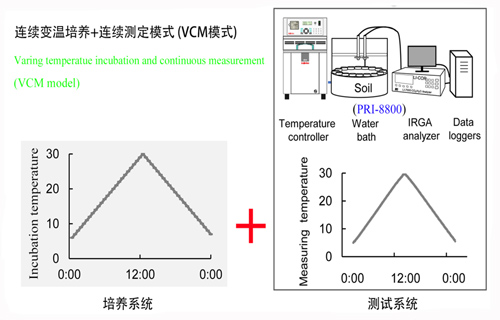土壤有机质(SOM)对温度变化的响应,不仅影响土壤养分循环、还影响陆地生态系统碳源/汇效应。土壤有机质分解的温度敏感性(Q10)不仅是生态学和土壤学研究的核心科学问题之一,也是全球变化生态学研究的热点领域。国内外学者对Q10的影响因素或机制开展了大量卓有成效的研究工作,并有不少相关的综述或展望;然而,迄今为止有关培养与测定模式的探讨却非常少。
传统上,科研人员广泛采用了恒温培养+间断测定模式(CDM模式);即通过设置3~6个恒定温度对土壤进行培养(如5、10、15、20、25 oC等),然后在天、周、月间隔,测定土壤有机碳分解速率(Rs);在测试方法上,大多采用碱液吸收法或气相色谱法进行测定,然后再利用所测定的Rs和对应温度计算Q10。后来,也有人在此基础上提出将土壤培养改良为连续变温的模式,即连续变温培养+间段测试模式(VDM模式)。这两种经典模式极大地推动了SOM分解对温度响应的研究,但却无法从理论、算法、操作上克服其固有的问题(详见原文讨论)。
为了克服CDM和VDM模式的弊端,在总结前人相关研究基础上,中科院地理资源所何念鹏研究团队发展了连续变温培养结合连续–高频土壤微生物呼吸速率的测定装置与技术(PRI-8800),并发展了Q10研究的连续变温培养+连续自动测试的新模式(图, VCM模式)。VCM模式充分利用连续变温培养+连续–高频土壤微生物呼吸测定装置联用的优势,实现了对土壤样品连续变温培养,基本克服了CDM模式中土壤微生物对特定培养温度的适应性和底物消耗不均的重要缺陷。VCM模式通过开发连续–高频土壤微生物呼吸测定系统,可结合培养过程的温度特征,在升/降温过程中对每个样品进行连续的、高频度的测试。通过测定更多温度下土壤微生物呼吸速率,从而提高Q10的拟合精度。同时,在新设备支持下,VCM模式的培养与测试过程非常简单快捷,有利于开展大量样品测试或大尺度联网研究。
在理论上深入探讨三种模式优缺点的基础上,研究团队结合三种模式开展了多点的对比性案例研究,有关VCM模式优缺点和应用前景的相关论文近期在土壤学领域国际著名期刊《Soil Biology & Biochemistry》正式在线发表。该论文是团队前期大量研究的延续,为今后国内外开展SOM分解对温度变化响应的相关研究提供了可借鉴的方法学。
相关研究受到国家自然科学基金项目(31770655,41571130043)、国家重点研发计划项目(2016YFC0500102)、生态系统观测与模拟重点实验室青年团队项目(LENOM2016Q0005)等项目的资助。
 |
|
SOM分解对温度变化响应的连续变温培养+连续测定模式(VCM模式)
|
相关研究论文
1. Liu Y, He NP, Xu L, et al. 2019. A new incubation and measurement approach to estimate the temperature response of soil organic matter decomposition. Soil Biology & Biochemistry, 138, 107596. (原文:www.sciencedirect.com/science/article/pii/S0038071719302603)
2. Liu Y, He NP, Wen XF, et al., 2018. The optimum temperature of soil microbial respiration: Patterns and controls. Soil Biology and Biochemistry, 121: 35-42.
3. Liu Y, Wen XF, He NP. Widespread asymmetric response of soil heterotrophic respiration to warming and cooling. Science of Total Environment, 635: 423-431.
4. Wang Q, He NP, Xu L, et al., 2018. Important interaction of chemicals, microbial biomass and dissolved substrates in the diel hysteresis loop of soil heterotrophic respiration. Plant and Soil, 428: 279-290.
5. Wang Q, He NP, Xu L, et al., 2018. Microbial properties regulate spatial variation in the differences in heterotrophic respiration and its temperature sensitivity between primary and secondary forests from tropical to cold-temperate zones. Agriculture and Forest Meteorology, 262, 81-88.
6. Li J, He NP, Xu L, et al., 2017. Asymmetric responses of soil heterotrophic respiration to rising and decreasing temperatures. Soil Biology & Biochemistry, 106: 18-27.
7. Liu Y, He NP, Xu L, et al., 2017. Regional variation in the temperature sensitivity of soil organic matter decomposition in China’s forests and grasslands. Global Change Biology, 23: 3393-3402.
8. Wang Q, He NP, Liu Y, et al., 2016. Strong pulse effects of precipitation event on soil microbial respiration in temperate forests. Geoderma, 275: 67-73.
9. Wang Q, He NP, Yu GR, et al., 2016. Soil microbial respiration rate and temperature sensitivity along a north-south forest transect in eastern China: Patterns and influencing factors. Journal of Geophysical Research: Biogeosciences, 121: 399-410.
10. He NP, Wang RM, Dai JZ, et al., 2013. Changes in the temperature sensitivity of SOM decomposition with grassland succession: Implications for soil C sequestration. Ecology and Evolution, 3: 5045-5054.